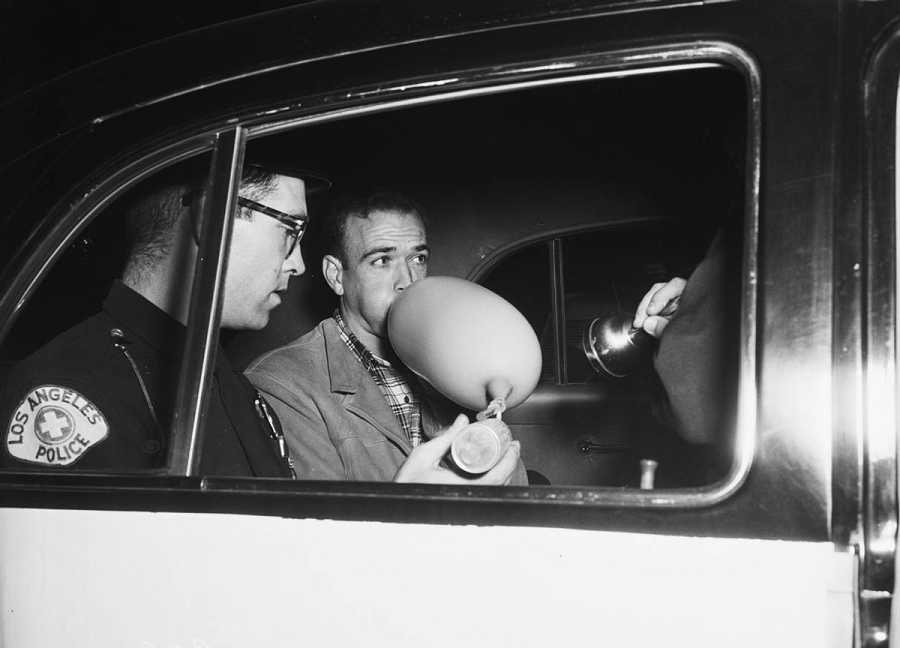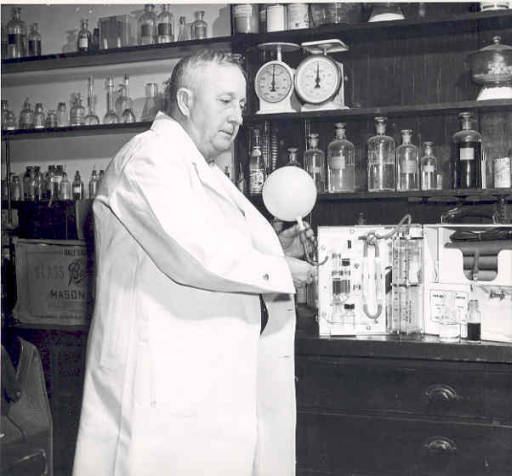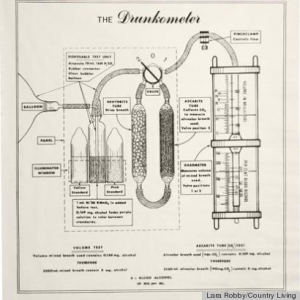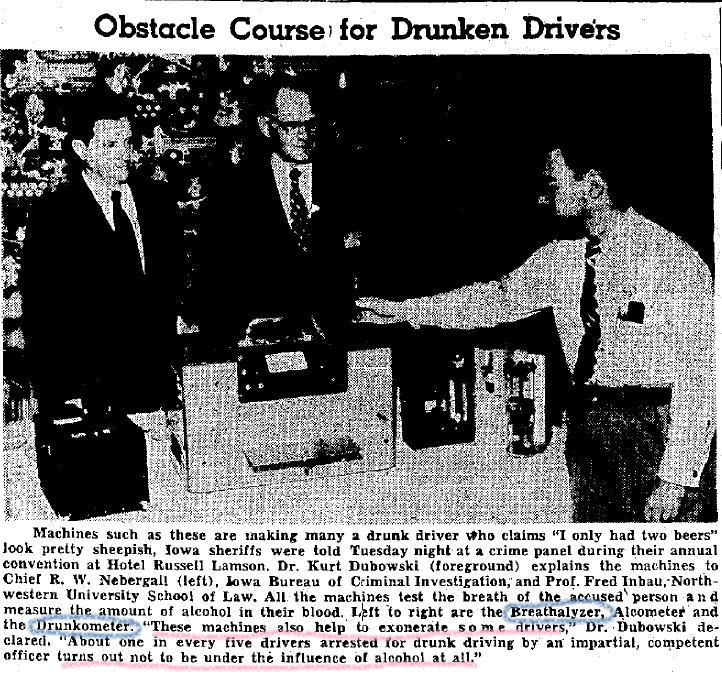
Wired magazine aptly noted “Inebriation is apparently a subject of some interest in Indiana.” Indeed, one of the greatest deterrents against drunk driving has roots with Indiana University School of Medicine’s professor Dr. Rolla N. Harger. The professor taught biochemistry and toxicology from 1922-1960 and headed the school’s department of biochemistry and pharmacology from 1933-1956. Harger began developing the first successful breath-testing instrument in the 1930s, descriptively dubbing it the Drunkometer. Although a somewhat bulky device, it proved innovative in the rapid detection of alcohol consumption. After subjects breathed into a balloon, a chemical solution was applied to the air, darkening in color according to the amount of alcohol detected.
Wired elaborated that:
From there, the level of alcohol in the person’s bloodstream was estimated using a mathematical formula, which Harger also developed. As he pushed for his patent, Harger also pushed to outlaw drunk driving, which, in the wake of Prohibition’s end, was becoming more than a nuisance.

Harger’s Drunkometer was patented in 1936 and Indianapolis police successfully tested the device on New Years Eve of 1938. Harger’s crusade against inebriated drivers didn’t end there. He served as a member of a subcommittee of the National Safety Council that drafted an act to use chemical tests as evidence of impaired driving. The subcommittee also established limits for motorist alcohol consumption, which went into effect nationally.

Harger’s invention was foundational to the Breathalyzer, invented by Hoosier Robert F. Borkenstein. Born on August 31, 1912, Borkenstein grew up in Fort Wayne. He entered the work force as a photographic technician. During the early 1930s he developed a color printing process, which was received favorably by the commercial market.
In 1936, Borkenstein took a position with the Indiana State Police and became involved with the early research and development of lie detector technology. Eventually this work led to his being named captain and head of laboratory services. It was then that he noticed the importance of the Drunkometer technology, but also recognized the difficulty in operating it effectively in the field.
Borkenstein enrolled at IU and began his collaboration with Dr. Harger in advancing the Drunkometer. By 1954, Borkenstein independently invented a more practical, user-friendly means of detecting Blood Alcohol Content (BAC), now known as the Breathalyzer. His ingenuity served him well and when he had earned a Bachelor of Arts degree in 1958 from IU, Borkenstein was named a professor in the school’s Department of Forensic Studies that same year. When IU formed its department of Police Administration he was named its chairman.

The Breathalyzer revolutionized law enforcement’s efforts to measure alcohol in the blood when investigating an accident and suspecting drink as the culprit. By exhaling, breath alcohol vapors can be proportionally measured. The Breathalyzer instrument can calculate the proportion of alcohol in the blood.
When Borkenstein was elected to the National Safety Council’s Safety and Health Hall of Fame International in 1988, the Council noted that,
“This technological innovation enabled traffic enforcement authorities to determine and quantify blood alcohol concentrations with sufficient accuracy to meet the demands of legal evidence.”

Borkenstein continued to invent devices that could combat drunk driving by determining BAC. According to an IU Archives blog post, in 1970 he “introduced a coin-operated Breathalyzer that could be installed in cocktail lounges. For 25 cents, a person could blow into a straw that popped out of the machine.” Depending on the BAC, the machine would provide users with the messages: “Be a safe driver,” “Be a good walker,” or “You’re a passenger.”

Borkenstein devoted his life’s work to prohibiting drunk driving, serving president of the Academy of Criminal Justice Services, as well as the International Committee on Alcohol, Drugs and Traffic Safety and consultant to the President’s Task Force on Highway Safety. He supervised a 1981 liquor sturdy which revealed that driving with less than two ounces of alcohol prove less dangerous than a driver who abstained. The study concluded that a little alcohol could possibly assist a driver by relaxing him behind the wheel.
Borkenstein retired from IU professorship in the late 1980s. According to the Chicago Tribune, he “helped launch a class on alcohol and highway safety that became a requirement for law-enforcement personnel and forensic specialists in many jurisdictions. The university calls it the Borkenstein Course.” Despite his 1981 study, Borkenstein advocated abstinence of any drink prior to driving, before he died in Bloomington on August 15, 2002.
